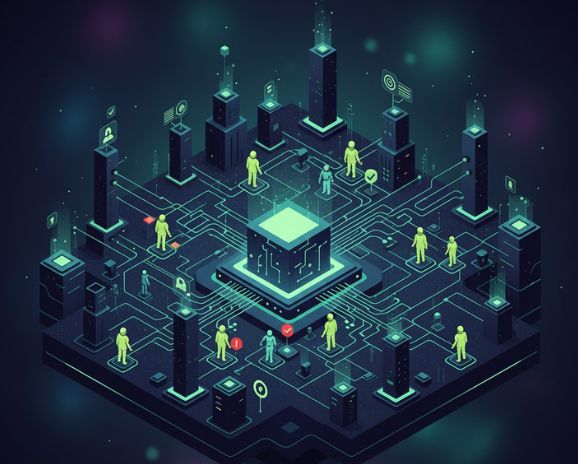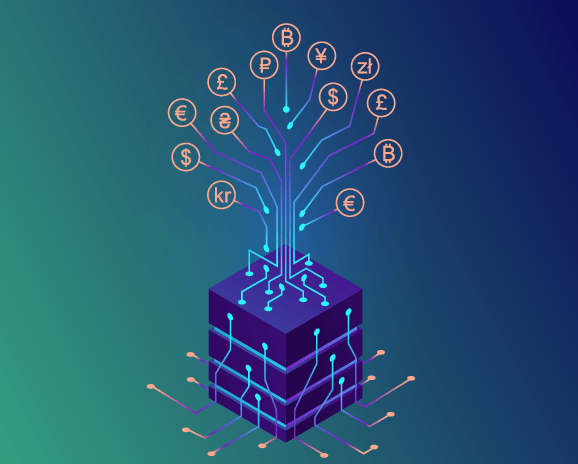Automation is Dead. Long Live Agentic Orchestration.

The software world is experiencing a fundamental change, moving from simple automation to true autonomy. This is the “agentic shift,” a transformation reflected in massive market momentum. The global agentic AI market, valued at $5.25 billion in 2024, is projected to explode to $199.05 billion by 2034. An agentic orchestration platform sits at the center of this shift, coordinating a dynamic ecosystem of specialized AI agents, legacy automation systems, and human experts. These components work together in a single workflow to execute complex, end-to-end business processes.
For decades, “automation” meant rigid, predefined scripts. Traditional automation is deterministic; it follows a strict, rules-based path. This model is collapsing under its own weight. Industry research shows that software teams spend a staggering 60-80% of their test automation effort just on maintenance. If the application or workflow changes even slightly, the script breaks, trapping engineers in a cycle of constant, costly human intervention.
Agentic Automation breaks this fragile cycle. It is goal-based and adaptive. Instead of following a static script, specialized Cognitive Reasoning agents perceive their environment, make independent decisions, and take actions to achieve a high-level goal. The focus shifts entirely from brittle “scripts” to resilient “goals”.
It is important to understand a key distinction. “AI Orchestration” (platforms like MLflow or Kubeflow) is an MLOps or data science function. It focuses on managing ML models, training, and data pipelines. Agentic Orchestration is different. It is a business process function that explicitly focuses on the real-time coordination of autonomous, decision-making agents to complete work.
Why Your QA Process Is Creating a Velocity Gap
Generative AI is accelerating development at a startling rate. At major tech companies, AI already writes between 20-40% of all new code. This surge in development speed has exposed a critical vulnerability: a massive “velocity gap”. Quality assurance (QA) practices, stuck in a manual or semi-automated past, simply cannot keep pace.

This creates a dangerous bottleneck, and the legacy QA model is failing on three distinct fronts:
- The Manual Bottleneck: Even in 2024, manual testing remains the single most time-consuming activity for 35% of companies. It’s a guaranteed chokepoint.
- The Maintenance Crisis: Teams that embraced traditional automation are now drowning in technical debt. As applications change, brittle scripts break. Up to 30% of a test engineer’s time is lost to just maintaining and fixing old tests, trapping them in a reactive, inefficient cycle.
- The Skills Gap: QA professionals see the iceberg coming. 82% of QA pros recognize that AI skills are critical for their careers, yet 42% of today’s engineers admit they lack the necessary machine learning expertise. This gap makes it impossible for most companies to “build their own” agentic systems, creating a clear need for a pre-built, autonomous solution.
This leads to a strategic imperative. You cannot pair an AI-driven development cycle with a human-driven QA process. Software testing is the primary proving ground for Agentic Automation because it directly addresses the core challenges of fragility, high maintenance, and slow delivery that plague quality assurance.
Traditional Test Automation Vs. Agentic Test Automation
| Dimension | Traditional Test Automation | Agentic Test Automation |
| Core Unit | Script-based | Goal-based |
| Structure & Flexibility | Linear and rigid; requires manual reprogramming for any change. | Non-linear and adaptive; agents can re-plan and self-correct. |
| Cognitive Capability | No context awareness; cannot handle ambiguity. | Perceives, decides, and acts using LLMs and reasoning engines. |
| Maintenance | High; brittle scripts break easily with application changes. | Low; features self-healing capabilities to adapt to changes. |
| Human Role | Script Author/Maintainer | Strategist/Overseer. |
| Scalability | Limited by maintenance overhead and script brittleness. | Natively scalable; agents can be added to handle growing workloads. |

Not All Agentic Orchestration Platforms Are Created Equal
The market for agentic orchestration platforms is expanding quickly, but the platforms themselves serve very different purposes. They generally fall into three distinct categories, each with a different focus and target user. Understanding these differences is critical to choosing the right solution.
Enterprise-Grade Platforms (Broad Business Process)
These are end-to-end, high-governance solutions designed to automate general business operations. Their goal is to orchestrate a hybrid workforce of Cognitive Reasoning agents, existing RPA bots, and human employees across the entire enterprise (think HR, Finance, and IT).
- UiPath: A leader in RPA, UiPath has expanded into Agentic Automation to orchestrate this complex workforce. Its platform includes “Maestro” for high-level orchestration, an “Agent Builder” for creating custom agents, and a “Trust Layer” focused on enterprise-grade governance. For testing, it offers an “Autopilot for Testers” and a “Test Cloud” that integrates with over 190 enterprise apps like SAP and Salesforce.
- IBM (watsonx Orchestrate): IBM’s platform focuses on natural language-driven automation for business professionals in regulated industries. It uses a centralized orchestration model to connect with over 80 enterprise applications, including deep integrations with SAP and Workday, ensuring strong governance and hybrid cloud deployment.
- Aisera: This platform categorizes its specialized agents by business function, offering “Prescriptive Knowledge Agents” for compliance, “Dynamic Workflow Agents,” and “User Assistant Agents” for tasks in customer service or logistics.
Developer-Centric Frameworks (Open-Source)
This category includes open-source toolkits for developer teams that need maximum flexibility to build custom agentic systems from scratch. These frameworks provide building blocks for multi-agent collaboration but require significant engineering effort.
- LangChain / LangGraph: A popular framework for building custom, stateful multi-agent systems. LangGraph, in particular, allows developers to define agent interactions as a graph, enabling more complex, cyclical reasoning.
- Microsoft AutoGen: An open-source framework from Microsoft that focuses on creating conversational, collaborative agents that “chat” with each other (and with humans) to solve complex tasks.
- CrewAI: A role-based framework where developers assign specific roles (like “researcher” or “writer”) and goals to a “crew” of agents, which then collaborate to achieve the objective.
AI-Enabled Workflow Platforms (Low-Code)
This third category is distinct. Tools like Domo are powerful but focus more on connecting data pipelines and AI models (not necessarily autonomous agents) into workflows. They are excellent at data automation and empowering business analysts, but they are not purpose-built for coordinating autonomous, decision-making Cognitive Reasoning agents to handle dynamic, complex processes.
A Vertical Solution for the Velocity Gap: The Qyrus SEER Framework
The general-purpose platforms just described are horizontal. They provide a broad toolkit to automate any business process, from HR to finance. Software testing is just one of many things they can do, but you must build the specialized testing agents yourself.
Qyrus is different. It is a vertical agentic orchestration platform. It was purpose-built with one goal: to solve the deep, complex problems of the software quality lifecycle and close the “velocity gap”.
The Qyrus SEER (Sense, Evaluate, Execute, Report) framework is an autonomous system architected to manage the entire testing lifecycle. It operates using a hierarchical orchestration model with three core components:
- AI-Powered Agents (SUAs): These are Specialized User Agents, each an expert in a specific QA task. Instead of one generalist agent, Qyrus deploys squads of specialists.
- The Orchestration Layer: This is the “central nervous system”. It intelligently deploys the right agents at the right time to achieve the testing objective.
- Continuous Feedback Loops: The system learns. It analyzes historical test results and defect trends to continuously improve its own strategy, making the entire process smarter with every cycle.
The SEER Framework in Action

The framework operates in a continuous, four-stage loop:
Stage 1: SENSE
In the Sense stage, Qyrus’ “Watch Tower” agents proactively monitor your entire ecosystem—GitHub, Jira, Figma—for changes in real-time. The system doesn’t wait for a manual trigger; it senses a change as it happens.
Stage 2: EVALUATE
The Evaluate stage works as the “cognitive core”. When a change is detected, a squad of “Thinking Agents” analyzes the potential impact to create a targeted test plan.
- Impact Analyzer: Traces the code change to see exactly what’s affected.
- Test Generator+: Uses NLP to read requirements in Jira or new design files to autonomously generate new test scenarios.
- UXtract: Extracts UI/UX changes directly from design platforms like Figma to inform test creation.
Stage 3: EXECUTE
The Execute stage performs an autonomous precision strike. The orchestration layer deploys a squad of “Execution Agents” to validate every layer of the application.
- TestPilot: Executes functional UI tests across web and mobile.
- API Builder: Validates backend services and complex workflows.
- Rover: An autonomous explorer that navigates the application to uncover hidden bugs and untested pathways that scripted tests miss.
- Healer: The maintenance expert. It automatically analyzes UI changes and repairs broken test scripts, delivering true self-healing.
Stage 4: REPORT
The Report stage is the “voice” of the operation. “Analyst Agents” transform raw data into business intelligence. The system provides AI-driven risk assessment to prioritize defects and delivers concise reports instantly to Slack, email, or Jira, closing the loop in minutes.
Horizontal vs. Vertical: Why a General Platform Isn’t a Testing Solution
The core difference between the platforms described earlier and a purpose-built system like Qyrus comes down to a simple concept: horizontal vs. vertical.
- General-Purpose (Horizontal) Platforms: Platforms like UiPath, IBM, and Aisera are horizontal. They are designed to orchestrate a wide range of general business process workflows across an entire enterprise. Their agents are built for tasks like “invoice processing,” “customer onboarding,” or “HR approvals”. While you could theoretically use their tools to build testing automation, it’s not their primary purpose. You would be starting from scratch, building your own specialized testing agents.
- Qyrus SEER (Vertical) Platform: Qyrus is vertical. It is a purpose-built agentic orchestration platform designed only to solve the deep, complex problems of the software quality lifecycle5. Every agent is pre-specialized for a specific QA task like Test Generation, Self-Healing, and Autonomous Exploration.

This difference is critical. You don’t use a general-purpose screwdriver to perform heart surgery; you use a specialized instrument. The same applies here.
Feature Comparison: General vs. QA-Specific Orchestration
| Capability | General Platforms (e.g., UiPath, IBM) | Qyrus SEER Platform |
| Primary Goal | Business Process Automation (HR, Finance, etc.) | Autonomous Software Quality Assurance |
| Specialized Agents | “Prescriptive Knowledge Agents,” “Workflow Agents” for business tasks. | “Test Generator+,” “Healer,” “Rover,” “UXtract” for specific QA tasks. |
| Test Generation | Requires manual modeling or a developer to build a new custom agent. | Autonomous. The Test Generator+ agent reads requirements (Jira) and auto-generates test cases. |
| Test Maintenance | High. Relies on brittle, scripted steps. | Autonomous. The Healer agent provides true self-healing, automatically repairing broken scripts. |
| Target User | Business Analysts, IT Process Managers. | QA Teams, Testers, Developers, and DevOps Engineers. |
How to Choose the Right Agentic Orchestration Platform
Your choice depends entirely on the primary business problem you are trying to solve. Ask yourself these two questions:
1. What is my real bottleneck?
Is your biggest problem slow, manual business approvals in HR or finance? If yes, a horizontal, general-purpose platform might be a good fit.
But if your biggest problem is the speed and quality of your software releases—if your bottleneck is testing, high maintenance, and a growing “velocity gap”—you need a vertical, purpose-built QA platform.
2. Do I want a “Platform” or a “Solution”?
Many general platforms provide tooling (like an “Agent Studio”) that lets you build an agentic solution from scratch. This requires a highly skilled team of AI and ML engineers and a significant investment in time.
A purpose-built platform like Qyrus provides a fully autonomous solution out-of-the-box. It comes with pre-built, specialized agents for every step of the testing lifecycle, ready to work on day one.
Conclusion: Stop Maintaining Scripts. Start Orchestrating Quality.
The “velocity gap” is the most critical challenge facing modern development. You cannot win a race in a sports car that’s being held back by a parachute. Yet, that’s what companies are doing when they pair up an AI-accelerated development pipeline with a manual, script-based QA process.
An agentic orchestration platform is the only viable solution to this problem, but as we’ve seen, not all platforms are built for the job.
The Qyrus SEER framework provides a definitive architectural answer. It is a purpose-built, vertical solution that deploys a squad of specialized Cognitive Reasoning agents to create a system that is invisible (operates autonomously in the background) and invincible (delivers higher quality, greater coverage, and unwavering confidence).
Stop trying to fix brittle scripts. It’s time to adopt a truly autonomous quality platform.
See how the Qyrus SEER framework can close your velocity gap and transform your QA from a bottleneck into an accelerator.
Schedule a Demo of the Qyrus SEER Framework!
Frequently Asked Questions (FAQ)
Q: What is the main difference between agentic orchestration and traditional test automation?
A: Traditional automation follows a rigid script (e.g., “click button A, then type X”). If the script breaks, a human must fix it. Agentic Automation is goal-based (e.g., “log in and verify the dashboard”). An autonomous agent uses AI to decide the best steps, and if the UI changes, it can adapt or self-heal to achieve the goal without human intervention.
Q: What is an “AI agent” and how is it different from an RPA bot?
A: An RPA bot is a “doer.” It’s designed to execute a simple, repetitive, rules-based task. An AI agent is a “decider” or “thinker.” It uses generative AI and Cognitive Reasoning to analyze information, make decisions, and autonomously handle complex workflows and unexpected changes.
Q: Will an agentic orchestration platform replace my QA team?
A: No, it elevates them. It automates the most time-consuming and frustrating parts of the job, like script maintenance—which can consume 50% of an engineer’s time—and repetitive test creation. This frees skilled engineers from being “script maintainers” and allows them to become “AI Testing Strategists,” focusing on high-level goals, risk analysis, and complex exploratory problems.
Q: Why can’t I just use a general-purpose platform like UiPath for testing?
A: You can, but it’s not built for it. General platforms are horizontal—they give you tools to automate any business process (like HR or finance). You would have to build your own specialized testing agents from scratch. Qyrus is a vertical platform—it comes pre-built with a full squad of specialized agents like Healer, Rover, and Test Generator+ designed specifically for the complex processes of software quality.




